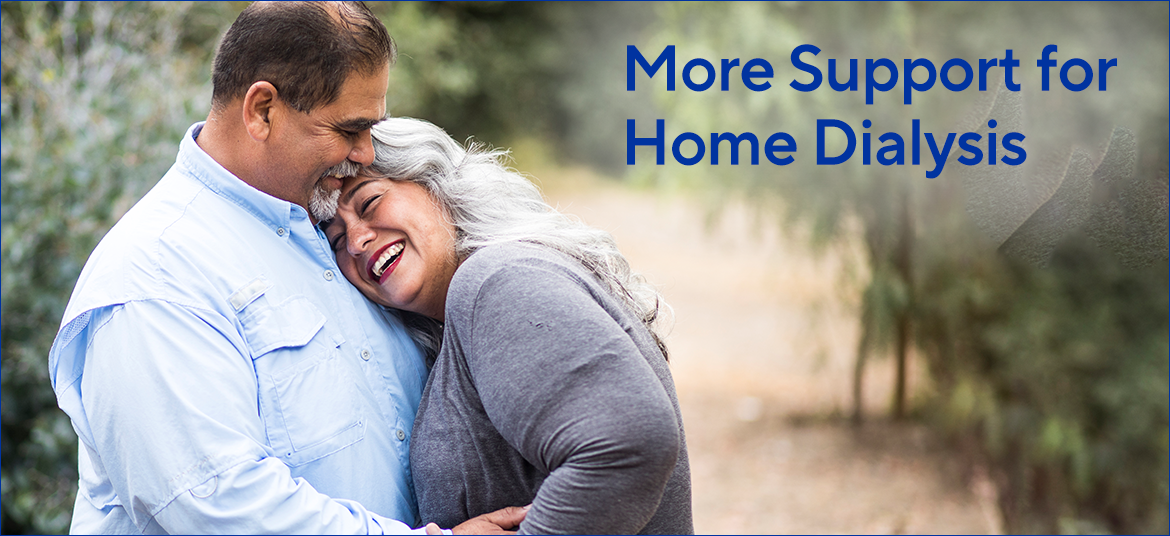
New Model Aims to Increase Home Dialysis and Kidney Transplants
The Centers for Medicare and Medicaid Services (CMS) launched the End Stage Renal Disease (ESRD) Treatment Choices (ETC) Model in January to increase the number of patients receiving home dialysis or transplantation.
The new effort comes out of the government’s Advancing American Kidney Health (AAKH) initiative and these goals are strongly supported by Fresenius Medical Care North America (FMCNA). The company has already successfully worked to empower more patients to choose home therapies.
“The Advancing American Kidney Health initiative has an ambitious goal to see 80 percent of new ESRD patients either start on home dialysis or receive a preemptive transplant by 2025,” said Dr. Terry Ketchersid, Chief Medical Officer for FMCNA’s Integrated Care Group and co-CMO for InterWell Health. “We understand the benefits for patients who choose home dialysis and have been working hard with our physician partners to empower even more patients to make this choice.”
For this mandatory ETC model, CMS randomly selected nephrologist practices and dialysis centers based on their location within certain hospital referral regions. 30 percent of these referral regions across the country will participate in the six-and-a-half-year model which runs through the middle of 2027.
The ETC model aims to adjust payments to providers and nephrologists participating in the program. During the first three years of the model, dialysis providers and nephrologists will receive a small bonus, called the Home Dialysis Payment Adjustment (HDPA) for home dialysis claims. The HDPA is intended to incentivize investment in home dialysis infrastructure as well as to provide resources to support broader adoption of home dialysis therapies and increase patient access to transplantation.
“We still have doctors who are a little bit uncomfortable with the therapy,” said Dr. Michael Kraus, Associate Chief Medical Office of Fresenius Kidney Care, in a recent Field Notes podcast about home dialysis. “It's our job to demonstrate to them that this is a safe and effective method, give them the evidence it takes to show the improvement in quality.”
According to the USRDS 2020 Annual Medical Report, at the end of 2018, there were 554,038 patients on dialysis. Out of these, 69,000 patients performed home dialysis, accounting for 12.5 percent of all patients undergoing dialysis.
While the benefits of home dialysis include a higher quality of life, some patients still do not realize home dialysis is an option for them. FMCNA made a commitment to growing home therapy treatments well before the government models were announced. In 2020, FMCNA provided more than 14 percent of its dialysis treatments in the U.S. in a home setting, with home hemodialysis growing at 37 percent.
“We have significantly invested in more support staff and have doubled the number of patients we train each month to help accelerate growth of home,” said Dr. Robert Kossmann, Chief Medical Officer for FMCNA. “As these new incentives roll out, we must all continue to work together to pave a brighter future for patients with kidney failure.”
Through KidneyCare:365, a recently launched FMNCA program, patients diagnosed with kidney disease are receiving high quality education about home dialysis. In addition to earlier intervention and prevention, the program provides extensive education about kidney disease, related comorbidities, and treatment options for kidney failure including transplant and home dialysis. It also emphasizes the importance of seeing a nephrologist, eating well, and living a healthy lifestyle. The goal of this care coordination is to achieve optimal health outcomes and slow the progression of their disease.
FMCNA also opened more than 100 new transitional care units (TCUs) in 2020. The TCUs offer a hands-on education around all treatment modalities including home dialysis, as they are designed to be a separate space within a dialysis center with staff dedicated to onboarding these new patients in their first weeks of treatment.
“Too many patients with chronic kidney disease do not receive a timely referral to a nephrologist,” said Ketchersid. “By working closely with our nephrologist partners and health plans, we are confident we have the ability to improve lives and outcomes for this vulnerable population.”
Kidney transplantation is widely viewed as the best choice for patients with ESRD, which increases survival and quality of life all while reducing medical expenditures. Fresenius Kidney Care has recently rolled out several new initiatives to better identify and encourage patients to be evaluated for the transplant list, helping more patients ultimately receive this gift of life.


